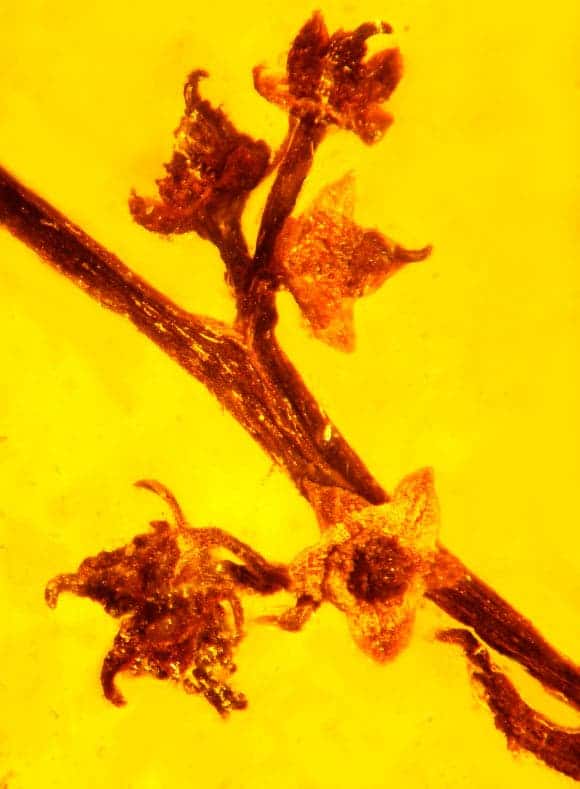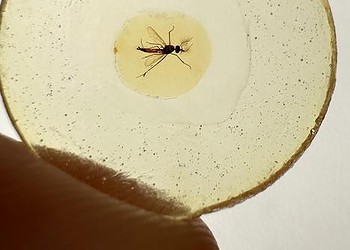- A cluster of 18 flowering plants from the Cretaceous (100 million years ago) has been found preserved in amber
- Among the flowers, one shows the earliest reproduction of flowering plants
- Based on microscopic imaging, paleontologists conclude that the pollination mechanism has remained virtually unchanged

Amber is fossilized tree resin, valued as a gem since prehistoric times. It is also used as an ingredient in perfumes, as a healing agent in folk medicine, but it’s even more valuable for scientists. Sometimes, mosquitoes, bugs, or even plants can get trapped inside the resin and fossilize alongside it, being preserved incredibly well by the amber, providing valuable clues as to how life was millions of years ago.
Such is the case with this 100 million year old fossil, dating from the Cretaceous. This is the oldest evidence of sexual reproduction in a flowering plant — a cluster of 18 tiny flowers, with one of them caught in the process of making some new seeds for the next generation.
The scene itself is perfectly preserved; it’s as if a painter was observing the scene and immortalized it to the smallest detail to capture its beauty for eternity. In the mid Cretaceous, flowering plants were in the process of changing the face of the Earth forever, adding biodiversity, food, and beauty to a relatively monotonous world.
“The evolution of flowering plants caused an enormous change in the biodiversity of life on Earth, especially in the tropics and subtropics,” said dr. George Poinar, Jr., a professor emeritus in the Department of Integrative Biology at the OSU College of Science. New associations between these small flowering plants and various types of insects and other animal life resulted in the successful distribution and evolution of these plants through most of the world today.”
Microscopic imaging revealed pollen tubes growing out of two grains of pollen and penetrating the flower’s stigma, the receptive part of the female reproductive system. This would basically start the egg fertilization process, which in turn would generate seed formation… had the reproductive act been completed.
“In Cretaceous flowers we’ve never before seen a fossil that shows the pollen tube actually entering the stigma,” Poinar said. “This is the beauty of amber fossils. They are preserved so rapidly after entering the resin that structures such as pollen grains and tubes can be detected with a microscope.”
But they were able to find out even more about this scene: the pollen appears to be sticky, which suggests it was carried around by a pollinating insect, adding further insights into the biodiversity and biology of life in the Cretaceous. At the time, the dominating plants were conifers, ferns, mosses, and cycads. Towards the end of the era mammals, birds, and flowering plants were gaining ground, but dinosaurs still pretty much dominated the planet. It’s fascinating to see that the biological mechanism has remained virtually unchanged for such a huge period of time.
“It’s interesting that the mechanisms for reproduction that are still with us today had already been established some 100 million years ago.”, Poinar concluded.
However, the bad news is that the seeds can’t actually be grown. DNA has a half life of about 500 years and it’s estimated that even if perfectly preserved anything older than 6.8 million years wouldn’t germinate.
Story Source:
The above story is based on materials provided by Oregon State University.






